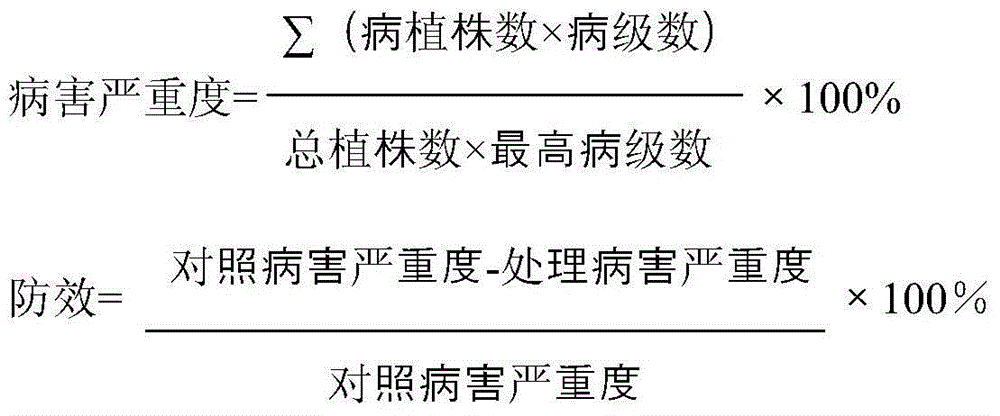Biocontrol strain for preventing and controlling fusarium wilt of watermelon and application thereof
A watermelon fusarium wilt and bio-control strain technology is applied in the field of watermelon fusarium wilt biological control, which can solve the problems of watermelon wilt, watermelon quality reduction, and long duration of chemical pesticides, so as to increase farmers' income, save farmers' expenses, The effect of improving the quality of watermelon
- Summary
- Abstract
- Description
- Claims
- Application Information
AI Technical Summary
Problems solved by technology
Method used
Image
Examples
Embodiment 1
[0020] Example 1 Screening method for biocontrol strains of watermelon fusarium wilt
[0021] The biocontrol strain for controlling watermelon wilt, Bacillus subtilis (Bacillus subtilis) XGY13-1, was isolated from soil in diseased fields in Nanjing, Jiangsu in 2013. The screening process is as follows:
[0022] In May 2013, samples were collected from plots with severe incidence of watermelon wilt in Lishui District, Nanjing City, Jiangsu Province. The five-point sampling method is adopted, and the interval between each point is at least 10m. The rhizosphere soil of three healthy plants was collected at each point and brought back to the laboratory for isolation.
[0023] Weigh 3g of rhizosphere soil, add to 27mL sterilized water (containing sterilized glass beads) respectively, vibrate on a shaker at 180rmp for 0.5h, and let stand for 5min to obtain 10 -1 Diluent, absorb 0.1mL supernatant and dilute in turn, take 10 -4 ---10 -6 Three gradient 0.1mL plates were coated with...
Embodiment 2
[0026] Embodiment 2 strain identification
[0027] The biocontrol strain used to prevent and control watermelon wilt, Bacillus subtilis (Bacillus subtilis) XGY13-1 is a Gram-positive bacillus with a single cell of 0.7-0.8×2-3 microns and uniform coloring. Uncapsulated, with periosteum flagella, able to move. The spores are 0.6-0.9×1.0-1.5 microns, elliptical to columnar, located in the center or slightly off the thallus, and the thallus does not expand after spore formation. The surface of the colony is rough and opaque, stained white or yellowish, and often forms wrinkles when growing in LB liquid medium. Aerobic bacteria. It can use protein, various sugars and starch to decompose tryptophan to form indole.
Embodiment 3
[0028] Example 3 Preparation of XGY13-1 biocontrol agent
[0029] LB liquid medium is: yeast powder 5g / L, tryptone 10g / L, sodium chloride 10g / L, adjust pH 7.0-7.2.
[0030] The fermentation liquid is: soybean flour 10g / L, corn flour 75g / L, dipotassium hydrogen phosphate 0.5g / L, magnesium sulfate heptahydrate 0.2g / L, yeast extract: 0.4g / L, sodium chloride 5g / L.
[0031] The isolated XGY13-1 single colony was picked into LB liquid medium, shaken and cultivated at 180 rpm at 30°C for 10 hours to obtain seed liquid. Inoculate the seed liquid with an inoculum of 1% on the above-mentioned fermentation medium, shake and culture at 30°C and 180rpm for 8-9 days, and the total concentration of viable bacteria in the finished bacterial preparation is 1×10 9 -1×10 10 CFU / mL.
PUM
 Login to View More
Login to View More Abstract
Description
Claims
Application Information
 Login to View More
Login to View More - Generate Ideas
- Intellectual Property
- Life Sciences
- Materials
- Tech Scout
- Unparalleled Data Quality
- Higher Quality Content
- 60% Fewer Hallucinations
Browse by: Latest US Patents, China's latest patents, Technical Efficacy Thesaurus, Application Domain, Technology Topic, Popular Technical Reports.
© 2025 PatSnap. All rights reserved.Legal|Privacy policy|Modern Slavery Act Transparency Statement|Sitemap|About US| Contact US: help@patsnap.com



